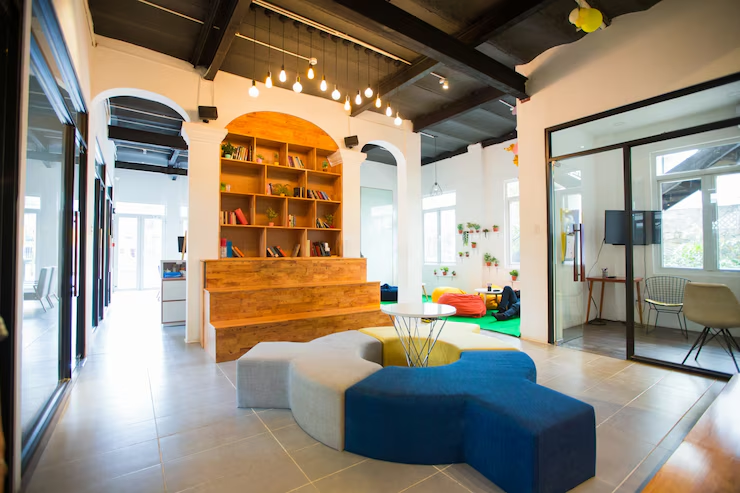Color has the remarkable ability to transform spaces, evoke emotions, and influence perceptions. When used strategically in architecture and interior design, it can enhance the aesthetic and functional qualities of a space. This post explores the power of color and how architectural elements can be utilized to elevate interior spaces, creating environments that are both visually stunning and emotionally engaging.
The Psychological Impact of Color
Colors have psychological effects that can influence our moods, behaviors, and overall well-being. Understanding these effects is crucial for architects and interior designers aiming to create harmonious and impactful spaces.
- Warm Colors: Reds, oranges, and yellows are energizing and stimulating. They can make spaces feel cozy and inviting, but should be used carefully to avoid overwhelming the senses.
- Cool Colors: Blues, greens, and purples are calming and soothing. These colors are ideal for creating serene environments, perfect for relaxation and contemplation.
- Neutral Colors: Whites, grays, and beiges provide a versatile backdrop that can enhance other colors and create a sense of balance and sophistication.
Architectural Elements and Color
Architectural elements provide the perfect canvas for applying color. By thoughtfully integrating color into these elements, designers can highlight architectural features, define spaces, and create dynamic visual interest.
- Walls and Ceilings:
- Accent Walls: Painting one wall in a bold color can create a focal point and add depth to a room. This technique works particularly well in living rooms and bedrooms.
- Ceiling Colors: A colored ceiling can make a space feel more intimate or add an unexpected design element. Light colors can make a room feel larger, while dark colors can create a cozy atmosphere.
- Windows and Doors:
- Trim and Frames: Painting window trims and door frames in contrasting colors can highlight these features and add character to a space.
- Colored Glass: Incorporating colored glass in windows or doors can create beautiful light effects and add a unique artistic touch.
- Floors:
- Tiles and Carpets: Using colorful tiles or carpets can define areas within open-plan spaces and add warmth and texture.
- Painted Floors: For a bold statement, painted floors can introduce vibrant hues and patterns, making the floor a standout feature.
- Structural Elements:
- Exposed Beams and Columns: Painting exposed structural elements can either make them blend seamlessly with the surroundings or stand out as unique design features.
- Staircases: Colorful staircases can become striking architectural statements, adding personality and interest to a home.
Harmonizing Color and Architecture
To effectively use color in architectural elements, it’s essential to consider the overall design and purpose of the space. Here are some strategies for harmonizing color with architecture:
- Consider the Function of the Space:
- Living Areas: Use warm, inviting colors to create a cozy atmosphere.
- Bedrooms: Opt for calming, cool colors to promote relaxation.
- Workspaces: Choose colors that enhance focus and creativity, such as soft blues and greens.
- Balance Bold and Neutral Colors:
- Balance vibrant colors with neutral tones to prevent spaces from feeling too overwhelming. Neutrals can provide a backdrop that allows bold colors to shine without dominating the space.
- Create a Color Palette:
- Develop a cohesive color palette that ties together different elements of the space. This palette should reflect the desired mood and style, ensuring a harmonious and unified design.
- Use Color to Highlight Architectural Features:
- Use contrasting colors to draw attention to architectural details such as moldings, trims, and built-in features. This can enhance the visual interest and uniqueness of a space.
- Incorporate Natural Light:
- Consider how natural light interacts with colors throughout the day. Natural light can change the perception of color, enhancing its effects and creating dynamic, evolving spaces.
Case Studies: Color in Architecture and Interior Design
- The Bauhaus Movement:
- The Bauhaus school of design emphasized the use of color in architecture to enhance form and function. Buildings such as the Bauhaus Dessau feature bold primary colors that highlight structural elements and create visual harmony.
- Le Corbusier’s Polychromie Architecturale:
- Renowned architect Le Corbusier developed a color palette that incorporated 63 shades, designed to evoke emotions and enhance architectural forms. His work demonstrates the power of color in creating mood and defining space.
- Modern Examples:
- Contemporary designers continue to explore the relationship between color and architecture. Projects like Zaha Hadid’s MAXXI Museum in Rome use color to accentuate fluid architectural forms and create immersive experiences.
Conclusion
Color is a powerful tool in architecture and interior design, capable of transforming spaces and enhancing their functionality and beauty. By thoughtfully incorporating color into architectural elements, designers can create environments that are not only visually stunning but also emotionally resonant.
Whether through bold accent walls, colorful structural elements, or carefully curated color palettes, the strategic use of color can elevate any space. Embrace the power of color in your architectural and interior design projects to create spaces that inspire, comfort, and captivate.




